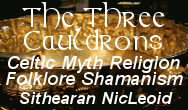Ariadne's Tribe: Minoan Spirituality for the Modern World
Walk the sacred labyrinth with Ariadne, the Minotaur, the Great Mothers, Dionysus, and the rest of the Minoan family of deities. Ariadne's Tribe is an independent spiritual tradition that brings the deities of the ancient Minoans alive in the modern world. We're a revivalist tradition, not a reconstructionist one. We rely heavily on shared gnosis and the practical realities of Paganism in the modern world. Ariadne's thread reaches across the millennia to connect us with the divine. Will you follow where it leads?
Find out all about Ariadne's Tribe at ariadnestribe.com. We're an inclusive, welcoming tradition, open to all who share our love for the Minoan deities and respect for our fellow human beings.
Minoans and history and untidy pigeonholes
When we learn history in school, we're given pictures of maps with clear lines drawn to separate the different empires, cultures, and nations. We're taught that one set of people lived within this little box on the map and another set of people lived within the next box over. But history isn't that neat and tidy.
Take the Minoans, for instance. Their culture centered on the island of Crete, just south of Greece, during the Bronze Age. They were a pre-Indo-European people (they weren't Greek) who became wealthy by importing raw materials and exporting fancy finished goods like bronze blades and dyed woolen cloth. But in order to do all that trading, they had to move around.
They had amazing ships that sailed all over the Mediterranean and possibly outside the Strait of Gibraltar as well. We find Minoan cities on ancient Thera as well as other islands around the eastern Mediterranean, and there were Minoan quarters in port cities along the Levant, and probably in the Nile delta and Mesopotamia as well. Just like today, people traveled for business and pleasure.
In Minoan Crete we find Egyptian and Mesopotamian goods - foreign deity figurines, imported ceramic and stone vessels, imported seal stones. It's likely that people moved back and forth along with the goods. Minoan merchants probably brought foreign wives (or husbands) back home. Foreign merchants may have set up headquarters on Crete if that suited their business ambitions. Wealthy families probably built alliances through marriage as well, sending daughters and sons to new homes around the Mediterranean.
Certainly there were diplomats, the ancient version of ambassadors and probably foreign spies as well on Crete. And if that's the case, we can count on the Minoans sending some of their own to the places they had the most contact with around the Mediterranean. We know artists moved around, because we find Minoan-style art in Egypt and the Levant. So either Minoan artists headed out to foreign countries for good paying work, or foreign artists came to Crete to study the Minoan art style, or both (probably both - the world isn't really an either/or kind of place).
There was also probably a certain amount of movement between temples: Minoan clergy may have traveled to foreign cities, to the temples there, to study or to stay. Foreign clergy may have come to Crete for similar reasons.
So when you look at a history book and it shows a map of the Mediterranean with Egypt here, and the Minoans there, and the Sumerians over there, that's a vastly over-simplified way to look at the situation. People moved around just as much in ancient times as they do now. The world has always been a fascinating place to explore.
Comments
-
Please login first in order for you to submit comments




















